This section contains entries about our botanizing in Baja California written for the UC BEE (Oct 2012 to Aug 2021)
and The UC Bee Hive (2022-), monthly newsletters for volunteers and staff of the UC Berkeley Botanical Garden.
Click on any photo for a larger image.
BEE JAN 2018
Backroad trip to Arroyo Las Chuparrosas
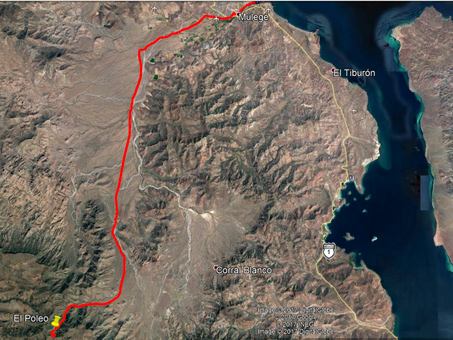 While many were sleeping off their Thanksgiving dinner, my friend Javier and I were in his dune buggy eating dirt while we made our way out into the far southwest corner of the Mulege valley to check out Arroyo Las Chuparrosas (see map below; click on the image to see a larger, more detailed map). It was my first time to that canyon and my first in a dune buggy.
While many were sleeping off their Thanksgiving dinner, my friend Javier and I were in his dune buggy eating dirt while we made our way out into the far southwest corner of the Mulege valley to check out Arroyo Las Chuparrosas (see map below; click on the image to see a larger, more detailed map). It was my first time to that canyon and my first in a dune buggy.
The valley floor begins at around 10 meters (33 ft.) above sea level near town and gradually climbs to between 200 and 260 meters (656-820 ft) in the southern end. The route we took made a sharp westward turn at about 30 km from town and 220 meters elevation, and then began to climb more quickly as we entered the canyon. 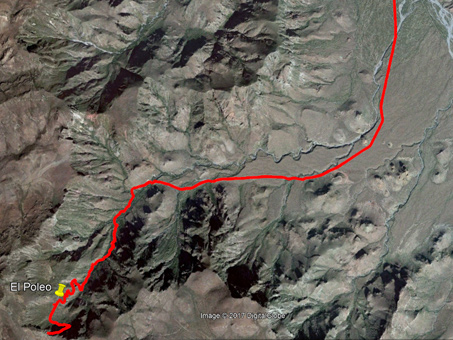 By the time we turned around near the top of the mountain pass, having driven 42 km (25 miles) from town, we had reached an altitude of 1040 m (3412 ft). The view was spectacular and almost made up for the harrowing final minutes of the uphill climb! However, I was very surprised how smooth the ride had been in general, in spite of the large rocks, occasional boulders, and potholes in the road bed that the buggy seemed to just float over. I was able to take in the view as we passed through wide, water-swept, barren arroyo beds, densely vegetated gullies and lush hillsides (click on the smaller map on the right for a closer view of the arroyo's terrain). At El Poleo, we stopped so Javier could collect some of the plant known as Poleo (Aloysia barbata, Verbenaceae), an aromatic herb used as a tea for treating colds and flu.
By the time we turned around near the top of the mountain pass, having driven 42 km (25 miles) from town, we had reached an altitude of 1040 m (3412 ft). The view was spectacular and almost made up for the harrowing final minutes of the uphill climb! However, I was very surprised how smooth the ride had been in general, in spite of the large rocks, occasional boulders, and potholes in the road bed that the buggy seemed to just float over. I was able to take in the view as we passed through wide, water-swept, barren arroyo beds, densely vegetated gullies and lush hillsides (click on the smaller map on the right for a closer view of the arroyo's terrain). At El Poleo, we stopped so Javier could collect some of the plant known as Poleo (Aloysia barbata, Verbenaceae), an aromatic herb used as a tea for treating colds and flu.
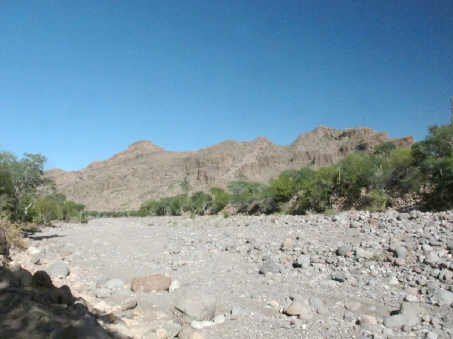
Watercourses recently carved by the past two or three flash floods.
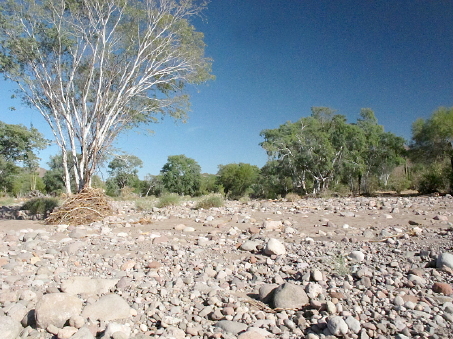
Debris line at the base of a Palo Blanco tree (Lysiloma candida, Fabaceae). Typical vegetation of dry watercourses can be seen here at about 120 m elevation and include: the leguminous trees Mesquite (Prosopis articulata), Dipúa/Little-leaf palo verde (Parkinsonia microphylla), Palo Fierro/ Desert Ironwood (Olneya tesota); Elephant trees/Torotes (Bursera hindsiana and B. microphylla, Burseraceae); and Lomboi/Ashy Limberbush (Jatropha cinerea, Euphorbiaceae).
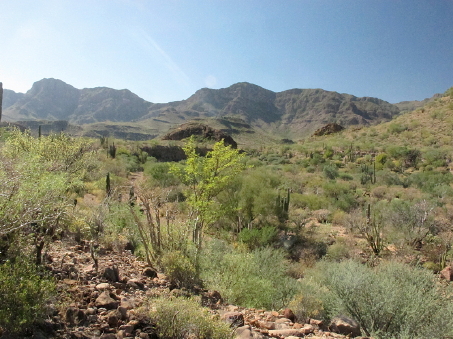
Cardón (Pachycereus pringlei), Pitahaya agria (Stenocereus gummosus), Pitahaya dulce (Stenocereus thurberi), and the peninsular endemic Cholla barbona (Cylindropuntia alcahes var. alcahes) are the most common and abundant cacti.
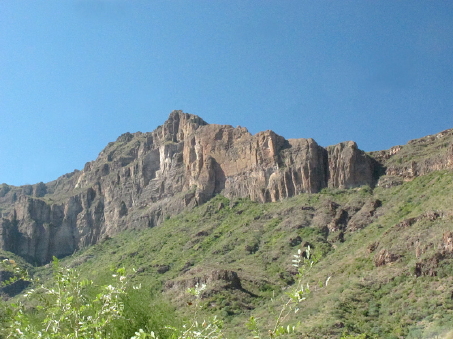
Starting the climb up into the canyon.
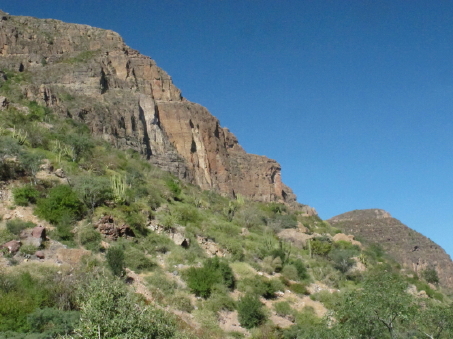
Looking along the east slope, towards the northwest.
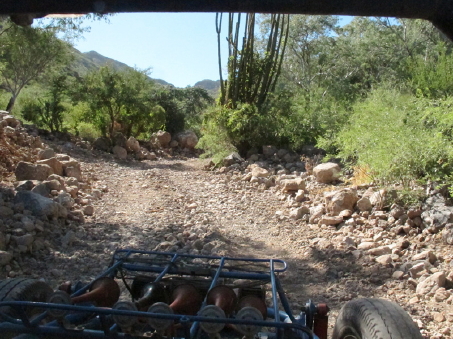
The road was steeper, narrower and looser from here on. We went in and out of dense vegetation along the way.
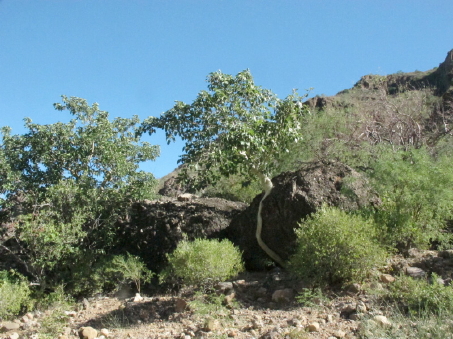
The figs appear to spring forth from boulders and in some places, to hang precariously from cliff faces.
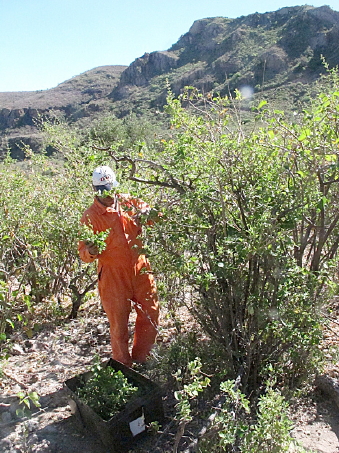
Harvesting some branches of Poleo/Baja California Beebrush (Aloysia barbata, Verbenaceae) for medicinal use.
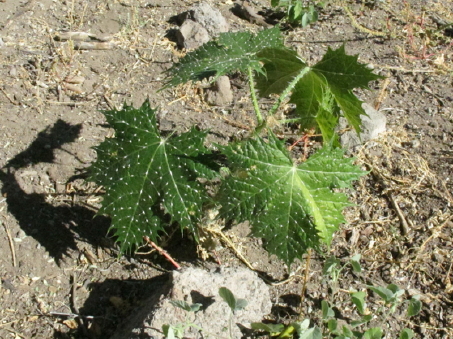
Such a beautiful, unusual plant. But DON'T TOUCH IT! Caribe/Spotted Bullnettle (Cnidoscolus maculata, Euphorbiaceae) has nasty, stinging hairs. Leaves are about 10-12 cm W. This is a BCS endemic, not seen at lower elevations around Mulegé.

"¿Quieres continuar? (Want to continue?)," Javier asked. "Claro. (Sure)," I responded.
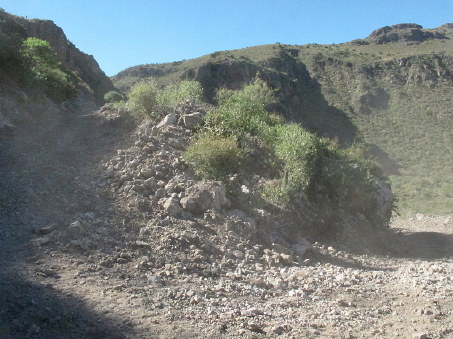
And up...
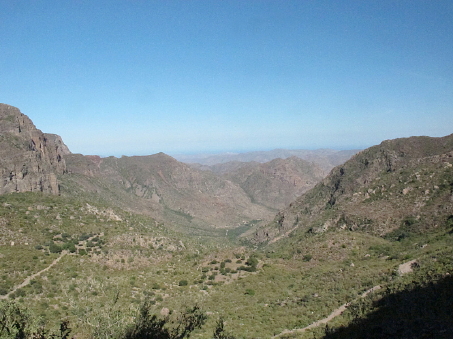
But what a view! (Note to self: Ignore that we are repeatly slipping towards the edge...)
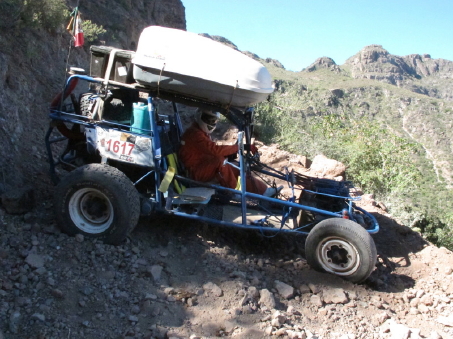
The road was just too loose to get any traction, so it was time to turn around! And we were only about 50 meters from the summit. I was happy to get out by that point after prying my fingers from the safety bar, my heart racing on pure adrenalin.
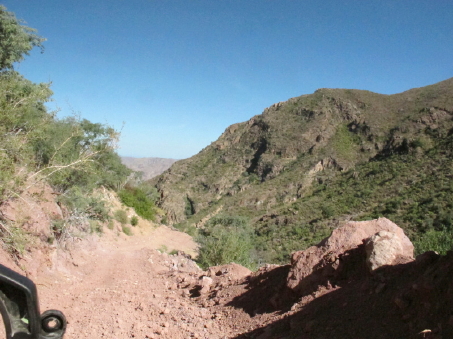
Down, down, down...
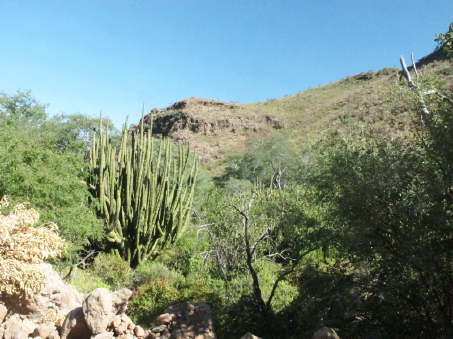
Getting to see the lush vegetation that I missed on the way up. Here, an enormous Pitahaya dulce/Organpipe Cactus (Stenocereus thurberi).
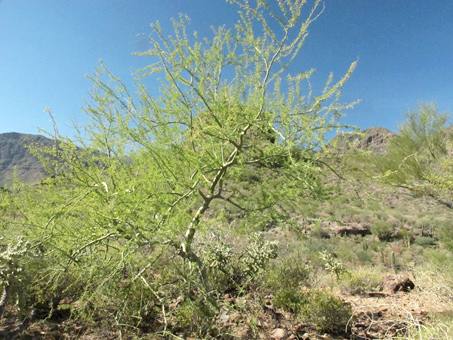
Palo Brea (Parkinsonia praecox). The bark is green all the way to the ground, and the branches are open, spreading, and contorted. Nodal spines are straight and 10-15 mm L.
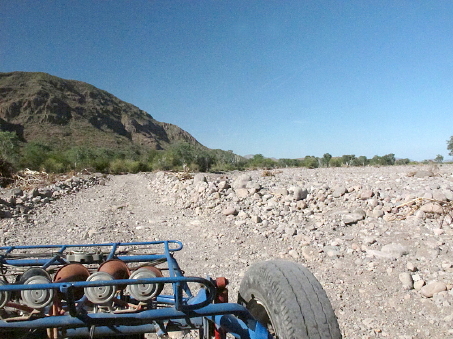
The bottom of the arroyos just keep getting wider after each successive flood.
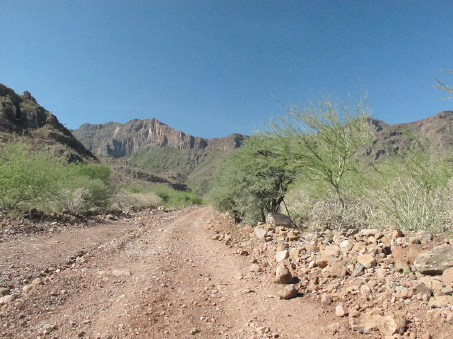
Just at, and above, 200 m elevation new species typical of the neighboring Sierra la Giganta ecoregion suddenly begin to appear. Common thornscrub species here include the native Palo Brea (Parkinsonia praecox), and two BCS endemic leguminous trees— Vinorama/Brandegee Acacia (Vachellia brandegeeana) and Palo Hierro/Palmer Mesquite (Prosopis palmeri).
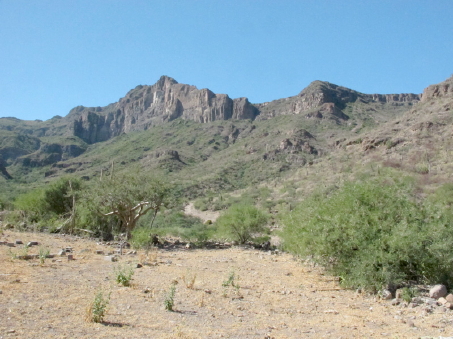
The views of the rocky outcrops of the Sierra Guadalupe are outstanding and the air was very clear on the day of our trip. The highest peaks are between 1000 and 1200 m (3280-3940 ft) across this range.
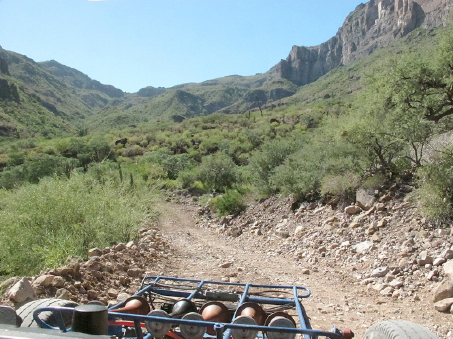
Vegetation on the slopes is much denser here, and includes vines such as Coral Vine/San Miguelito (Antigonon leptopus, Polygonaceae) and many small specimens of leguminous trees and shrubs.

From this point on, the local ranchers park their vehicles and continue on mule. We were soon to find out why.
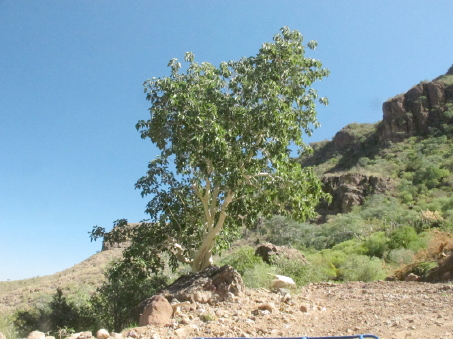
As we climbed, we passed many Zalate/Wild fig trees (Ficus palmeri, Moraceae).
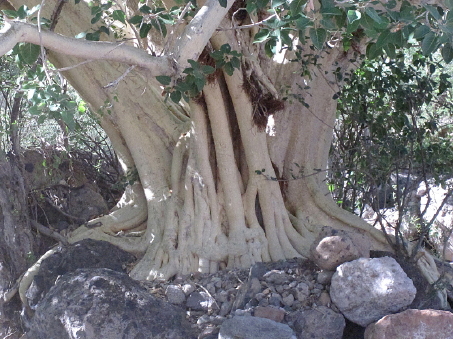
Closeup, the roots are clearly melded to the rocks. This has to be an old specimen, its multiple trunks at least 3 m across at the base.

Poleo/Baja California Beebrush (Aloysia barbata, Verbenaceae). The leaves have an unusual, sweet, and almost minty fragrance.
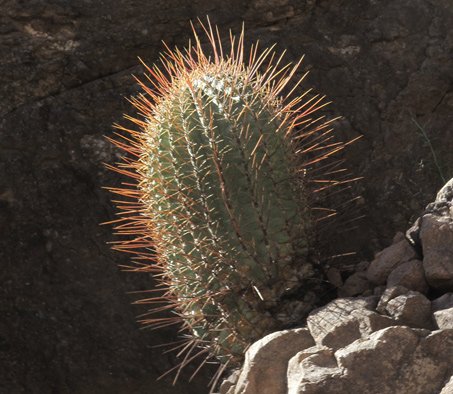
A lovely specimen of Biznaga/Long-spined Barrel Cactus (Ferocactus rectispinus, Cactaceae). Spines can reach 20 cm long! Flowers are pale orange or yellowish. A BCS endemic.
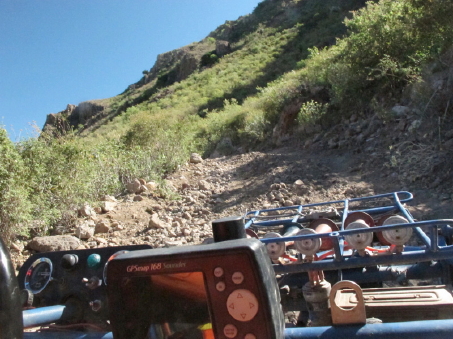
So up we went...
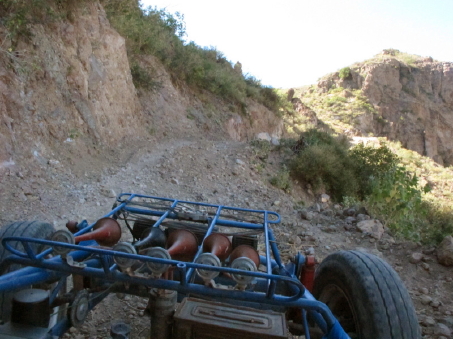
...and then...slipped and slid...towards the edge...

Gorgeous! (...and almost just tipped over!)
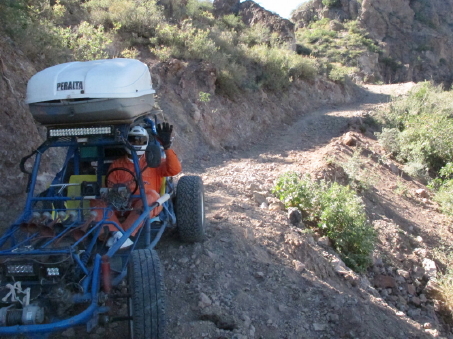
Finally, after a lot more slipping and sliding while Javier tried to turn around, the buggy was pointed in the right direction and we were ready to go down the hill, on the road, not via the vertical shortcut!
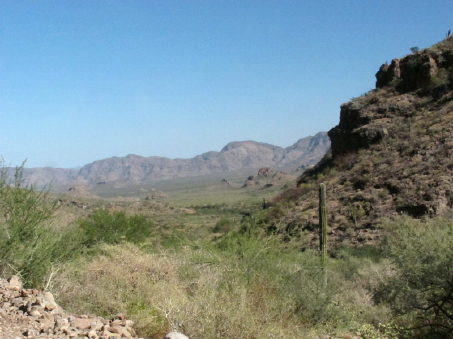
More great views, this of the southern end of the Mulegé valley.
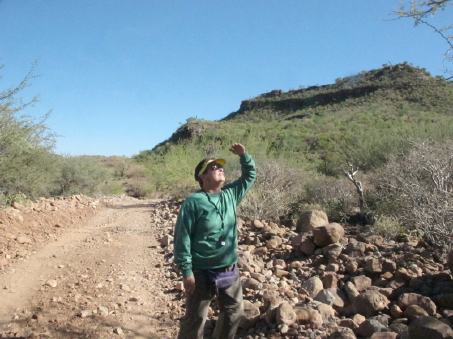
And back in the lowlands, we stopped so I could get a specimen of Palo Brea (Parkinsonia praecox, Fabaceae).
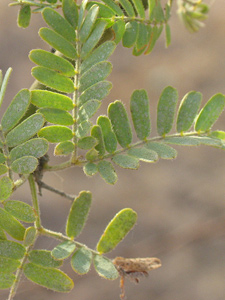
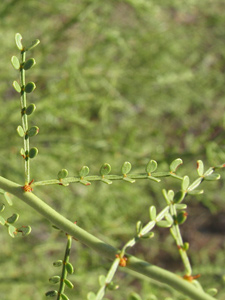
Leaflets of Palo brea (left) are 6-7 mm L and the bipinnate leaf, with 2-4 pinnae, are about 3 cm L. By comparison, Little-leaf Palo Verde (right) leaflets are 2mm L and the pinnate leaf, usually found in pairs or sometimes more at the node, is 2.5-3 cm L.
Back at the Ojo de Agua
Wow, what a big change at the Ojo de Agua. Having just finished my December Bee article on the wonderful plants there from early Spring 2017, I went to see what was happening there now. I knew that, given the flood this past September, there would likely be some changes. I'm not sure if I was expecting such a thorough cleanout of the area.

Here is the upper Mulegé River (looking downstream). It doesn't look too different now than earlier this year, though there is less vegetation along the banks. See this view in last month's issue.
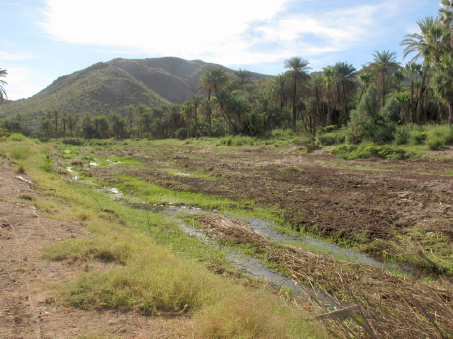
This is looking downstream from the northwest bank. I don't have a similar photo from last year. But what is visible is the flattened vegetation that was left. The central portion was swept clean and just a few plants have reestablished so far.

While there were much fewer plants overall, most of the species present earlier in the year had at least a few individuals present. Compare to image from March 2017.
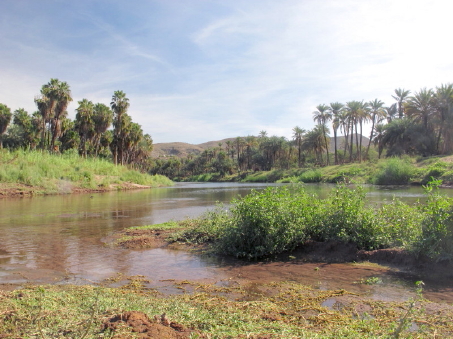
Lots of water, though here only a few inches deep. Not only does it bubble out of the river bottom in numerous places, but also seeps out of the bank to the right of this photo.

Another species known in Mexcio as Melón de Coyote and in English as Hedgehog Gourd (Cucumis dipsaceus, Cucurbitaceae). It is a non-native annual vine, seen by me in the area for the first time. It is very common from La Paz area and southward.
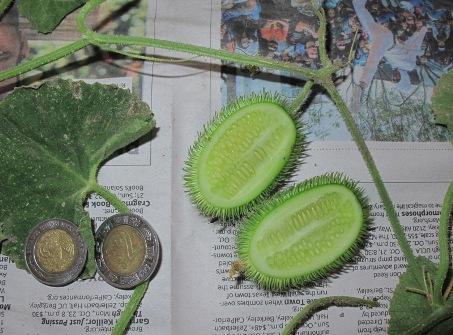
Specimen of Cucumis dipsaceus almost ready for pressing.
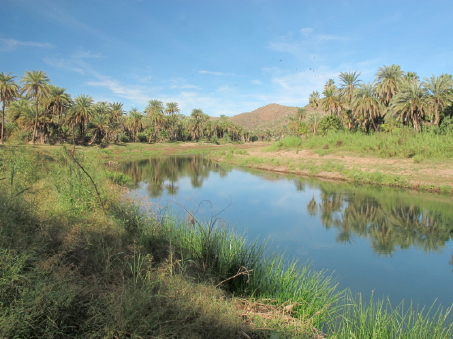
The upper river, looking upstream. Compare to last issue's image.
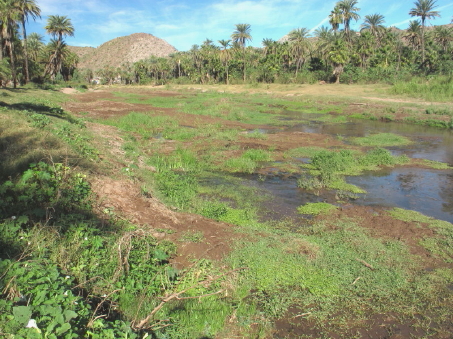
Looking upstream. Compare to January 2017 here. You can see an older image from a nearby spot taken in May 2013 here.
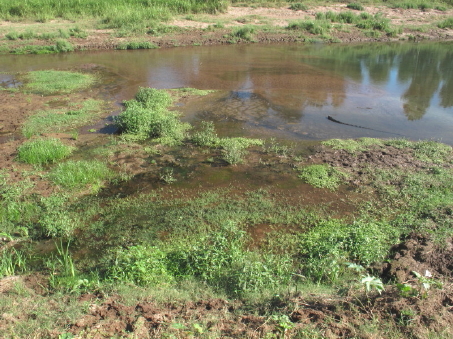
You can see an image here of this same view from March 2013.
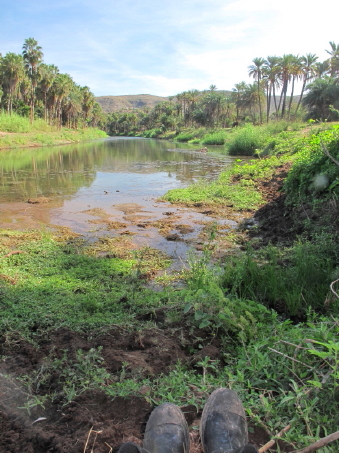
After slogging through the mud, it's time to sit, enjoy the solitude, birdsong, frogs, and babbling brook.
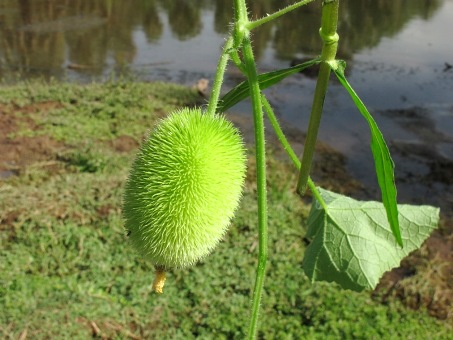
The pepo of Hedgehog Gourd is about 10 cm L and 3-4 cm D. It is densely covered with soft prickles, is juicy, full of seeds but bitter.
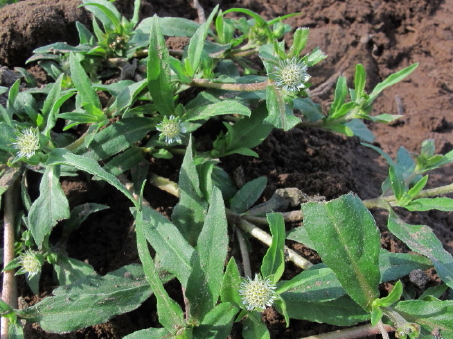
Clavel de Pozo (Eclipta prostrata) getting reestablished near the seep.
Flowers, butterflies and caterpillars...
A few more interesting plants and critters to wrap up this month's entry. I hope to have more adventures to share from the field next month. Until then, hasta la próxima…
Debra Valov—Curatorial volunteer
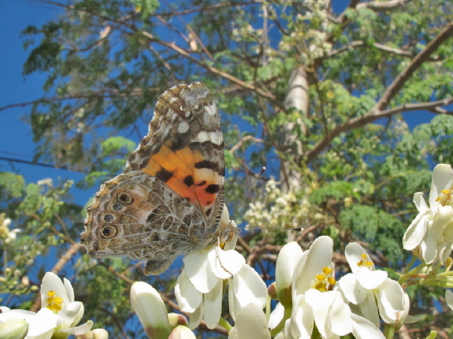
Painted lady (Vanessa cardui). This is a cosmopolitan butterfly species, found on all continents but Antarctica. There was a large group of these beauties flitting all over a neighborhood Moringa tree, alongside sulphur butterflies, bees and wasps. Adults feed on nectar from flowers in the Sunflower family, especially thistles where available, legumes and a variety of other butterfly-friendly plants.

Tinta/Baja California Stegnosperma (Stegnosperma halimifolia, Stegnospermataceae) is a native shrub with thick leaves. Its flowers have 5 white, deciduous petals and a showy crown of 10 stamens.
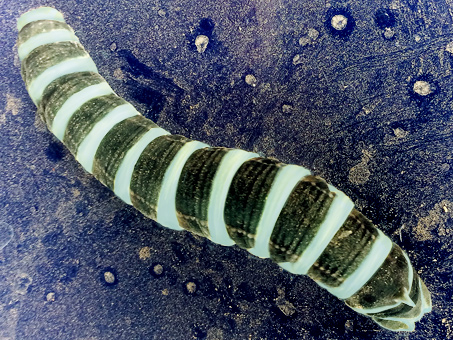
Pachlyia syces var. syces, a large hornworm caterpillar. This species feeds on a variety of fig trees (Ficus benjamina is the most common here). The larva is black with pale greenish-blue stripes, about 8-10 cm L x 1.5 cm D. It can move quickly across the ground (or bedroom tiled floor!) and when disturbed, will writhe and even squeak!. It occurs in Mexico and parts of Central and South America. Visit here for some images and more information on the moth and larva. I relocated this specimen from my bedroom to a pile of leaf litter outside. It seems to have entered through the roof after falling out of the overhanging Ficus tree.
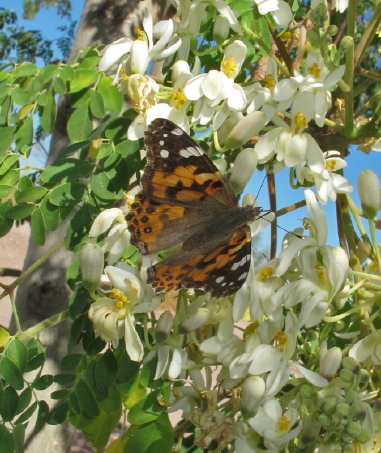
Painted lady (Vanessa cardui). Locally, the summer was quite wet and led to lush vegetation here in the area. There are over 100 host plants for the larvae, including plants in the sunflower and mallow families. We don't have thistles, but there are many mallows and sunflowers in the desert here.
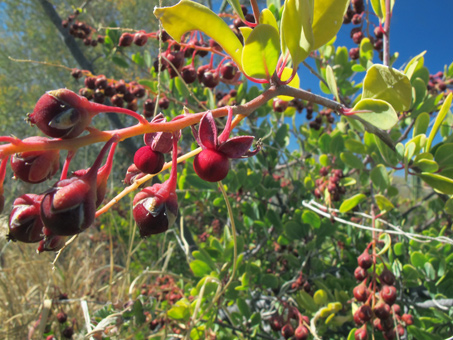
Tinta has globose fruit with a red outer covering (see the fruit with reflexed valves at center). The seeds beneath that are enclosed in a bright red aril.
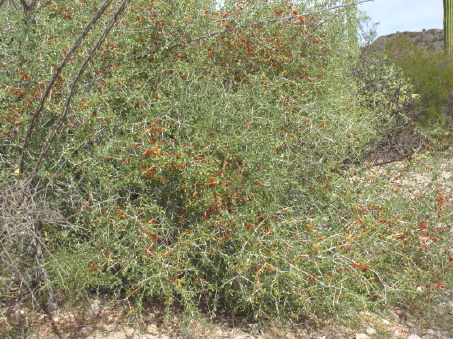
Sarampion (Schaefferia cuneifolia, Celastraceae). This common desert shrub has small, slightly fleshy drupes in copious amounts that are attractive to birds. Click the image for a close-up view that explains why this shrub's common name in Spanish means "measles".






















































